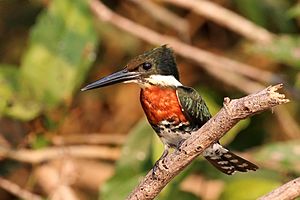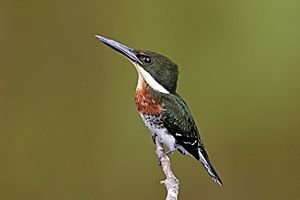Green kingfisher facts for kids
Quick facts for kids Green kingfisher |
|
|---|---|
 |
|
| Male C. a. americana, the Pantanal, Brazil | |
| Conservation status | |
| Scientific classification | |
| Genus: |
Chloroceryle
|
| Species: |
americana
|
| Subspecies | |
|
C. a. americana |
|
 |
|

The green kingfisher (Chloroceryle americana) is a resident breeding bird which occurs from southern Texas in the United States south through Central and South America to central Argentina.
This small kingfisher breeds by streams in forests or mangroves. The nest is in a horizontal tunnel which is dug by both sexes. It is up to a metre long made in a river bank. The female lays between three and six white eggs.
Green kingfishers are often seen perched on a low shaded branch close to water before plunging in head first after fish. They also eat aquatic insects. These birds often give a pebbly rattling call.
Contents
Taxonomy
The first formal description of the green kingfisher was by the German naturalist Johann Friedrich Gmelin in 1788 under the binomial name Alcedo america. The current genus Chloroceryle was erected by Johann Jakob Kaup in 1848.
A molecular phylogenetic study published in 2006 found that the green kingfisher is a sister species to the larger green-and-rufous kingfisher (Chloroceryle inda).
There are five subspecies:
- C. a. hachisukai (Laubmann, 1941) – south central USA and northwest Mexico
- C. a. septentrionalis (Sharpe, 1892) – south central Texas and east Mexico south to north Colombia and west Venezuela
- C. a. americana (Gmelin, JF, 1788) – South America east of the Andes from Venezuela to northeast Bolivia, and north and central Brazil, Trinidad and Tobago
- C. a. mathewsii Laubmann, 1927 – south Brazil, south Bolivia and north Argentina
- C. a. cabanisii (Tschudi, 1846) – Colombia to Chile west of the Andes
Birds occurring on Trinidad and Tobago, usually included with C. americana, have a larger and heavier bill than the mainland forms, and are sometimes separated as subspecies C. croteta.
Description
The green kingfisher is 20 cm (7.9 in) long. The male weighs 29–40 g (1.0–1.4 oz) and the female 33–55 g (1.2–1.9 oz). It has the typical kingfisher shape, with a short tail and long bill. It is oily green above, with white markings on the wings and tail, and a white collar around the neck. Males have white underparts apart from a broad chestnut breast band and some green spotting on the flanks. Females have buff-white underparts with two green chest bands, the lower of which links to the green spotting along the sides of the belly. These birds often give a pebbly rattling call.
Behavior
This small kingfisher breeds by streams in forests or mangroves. The nest is a horizontal tunnel that is dug by both sexes in a river bank. The tunnel is 5–6 cm (2.0–2.4 in) wide and 1 m (3 ft 3 in) long. The female lays between three and six eggs which are incubated by the female at night and by both birds during the day. The chicks fledge about 27 days after hatching.
Green kingfishers are often seen perched on a low shaded branch close to water before plunging in head first after fish. They also eat aquatic insects.
- Green kingfisher species account at Neotropical Birds (Cornell Lab of Ornithology)
See also
 In Spanish: Martín pescador verde para niños
In Spanish: Martín pescador verde para niños


